| |
CELEBRATING PLACE
“I wrapped my legs in puttees, as was customary for Japanese hikers, and walked for hours through the still-burning areas of Tokyo in order to sketch the devastation,” wrote print artist Hiratsuka Un’ichi (1895–1997) the very day after the earthquake struck. Those sketches formed the basis for a 12-print series that was issued in 1925. In simply executed images—all devoid of people—collapsed bridges, toppled stone lanterns of famous temples, and tents to house the homeless erected on park grounds were rendered with lightly incised strokes.
|
|
“Scenes of Tokyo after the Earthquake”
Images from a 12-print series issued in 1925
by Hiratsuka Un’ichi
|
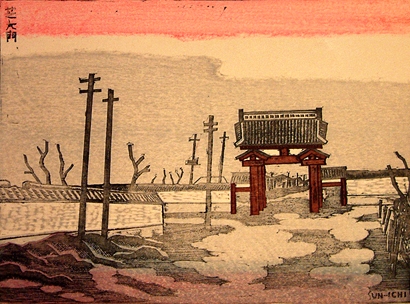 |
Great Gate at Shiba |
| Azuma Bridge |
 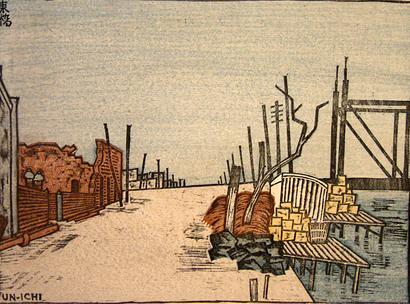 |
 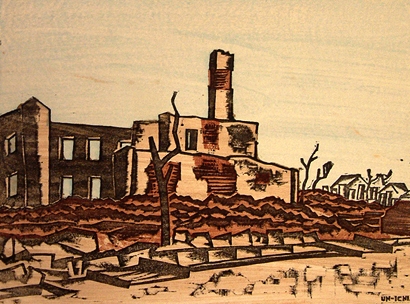 |
Seiroka Hospital, Tsukiji |
National Sports Palace
showing tents for people
made homeless by
the earthquake |
 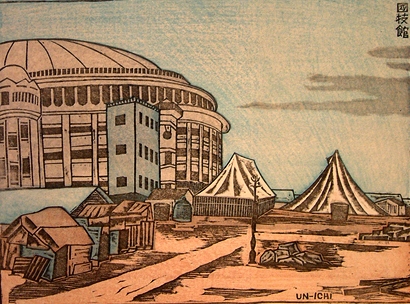 |

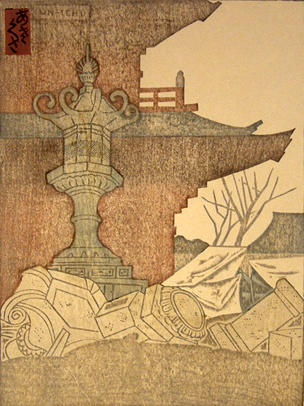
|

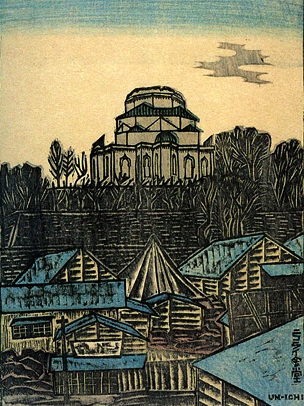
|
Asakusa Shrine
showing toppled
stone lanterns |
The Russian Orthodox Nicolai Cathedral
with damaged dome and tents
for homeless |
Five College Museums/Historic Deerfield Collections
|
| |
Hiratsuka’s walk through the devastated city was the most recent incarnation of a ritual as old as historical memory. Deep within Japanese religious sensibility is the notion of the animate quality of “place”—not as a generic category but as an abode of spirits. Animism located the unquantifiable qualities of the spirit world in the materiality of auspicious features of the natural world—mountains, gorges, valleys, rocks jutting from cliffs, ancient trees, waterfalls.
Honoring place recognized the productive cycles of the natural world: the stability of climate, recurrence of planting and harvest, and generally beneficial relationships among humans. Sites singled out for praise in rituals and verse date back to at least the 6th century, and as time passed this became more codified in religious practices, court rituals, and literary conventions. The four seasons formed the thematic foundation, and the range of human emotion was poetically reflected in the nuances of the changing natural world. For example, a poem combining the name of Mt. Kasuga in Nara with reference to the cry of deer and, under their hooves, the crunch of autumn leaves created a series of indelible associations relating that specific place with autumn, melancholy, love’s longings, and the evanescence of human existence. The famous early 13th-century anthology 100 Poems by 100 Poets (Ogura Hyakkunin Isshu) became the best known of a number of collections created during the 12th and 13th centuries that employed the organizing number “100” as a formula for establishing a canon of poets and themes. (The number probably derives from earlier Chinese practice to denote something complete, bountiful, and auspicious.)
The long journey from Tokyo’s earthquake-devastated landscape to a city reordered, rebuilt, and renewed, was narrated in official literature as a kind of “march of progress,” a sequence of mercantile successes and modernizing projects. Yet, contrary news—resistance and war in China, political assassinations at home—gave Japanese reason to view the newly formed city and its outlying empire with some skepticism. And beneath the vicissitudes of daily life the earthquake had left a permanent memory scar that quietly mocked optimism. Living in the new city required adjustment to changed configurations, different points of emphasis, and, most importantly, resetting awareness of the places that conveyed a sense of identity and stability.
From the late 16th century, with the political stabilization of Japan under the reign of the Tokugawa clan, “place” also came to be understood as notable sites within the growing urban landscapes of Edo (later Tokyo), Kyoto, and Osaka. Elite patrons commissioned folding screen paintings that offered panoramic views of Kyoto, the ancient capital that had vigorously rebounded from the devastation caused by a century of civil war. These views of the city acknowledged the role of the merchant class in restoring prosperity, made note of key shrines and temples, and paid due attention to the abodes of the powerful. Somewhat later, similar paintings were made of Edo, the eastern metropolis and residence of the Tokugawa shogun. Edo was the de facto seat of power, while Kyoto remained the nominal capital. The periodic destruction wrought on these cities by earthquake and fire occasioned additional rounds of image-making to announce reconstruction and return to normalcy.
Publishers of woodblock prints—a medium originally introduced in the 17th and 18th centuries to record life in the pleasure quarters of the great urban centers—discovered a wider audience and lessening pressure from government censors when urban landscapes, sites along the great highways connecting Edo and Kyoto, and other explorations of national geography were chosen over more salacious subjects. The heyday of this landscape and place-related print subject matter occurred in the first half of the 19th century when Hokusai (1760–1849) and Hiroshige (1797–1858) created series that employed age-old numeric formulae of literature to clever advantage. Hokusai’s 36 Views of Mt. Fuji—the “36” being a reference to the 36 immortal poets of ancient times—exemplified this, alongside various renderings of “100 views of Edo” and other locales.
Use of the formula continued after the Meiji Restoration in 1868, when the celebrated illustrator and print designer Kobayashi Kiyochika (1847–1915) and others documented the increasingly Western look of Tokyo (the name Edo was changed to Tokyo in 1868). While there is a documentable line of development from religious, through poetic, to more reportorial celebrations of “place” over the course of nearly 12 centuries, one outlook did not supplant the other. Site-specific associations continued to accrue over time to become, ultimately, richly unmanageable. The process of grafting new sites onto a preexisting canon of culturally significant places acknowledged the inevitability of change and at the same time alerted the audience to an unfolding interpretive complexity.
|
|
Different Times, Same Place
Famous places in Tokyo (formerly Edo) were revisited
by
different artists in different eras, as seen in this juxtaposition.
Hiroshige (1850s) Kiyochika (1870s-80s) Koizumi (1930s)
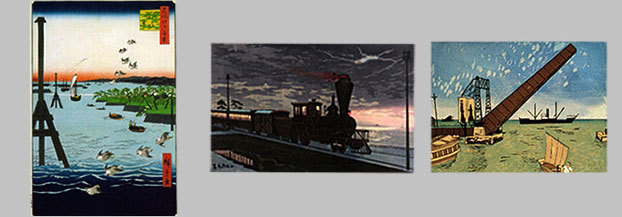
|
Location: Shibaura
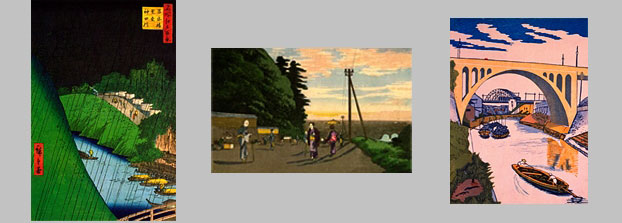
|
Location: Kanda River
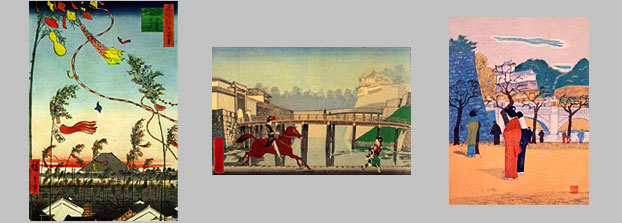
|
Location: Edo Castle
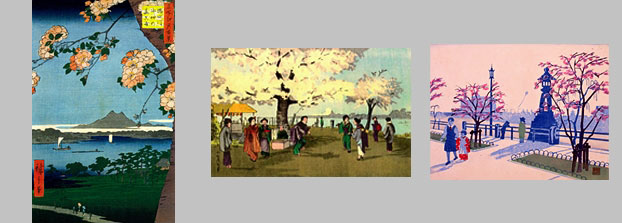
|
Location: Mukojima
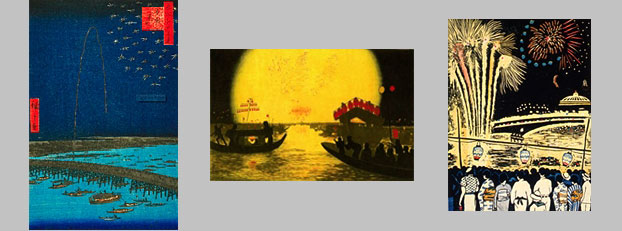
|
Location: Ryōgoku
HIroshige images: Freer Gallery of Art Study Collection
FSC-GR-71, FSC-GR-64, FSC-GR-70, FSC-GR-60
Freer Gallery of Art F1994.30
Kiyochia images: Robert O. Muller Collection, Arthur M. Sackler Gallery
S2003.8.1179, S2003.8.1142, S2003.8.1108, S2003.8.1162, S2003.8.1194
Koizumi images: #6 & #66,
Wolfsonian-Florida International University
#21, #30, #25, private collection
|
| |
As time passed, of course, new artistic conventions were introduced and new places were commemorated alongside more traditional ones. In his early 12-print rendering of Tokyo after the earthquake, for example, Hiratsuka Un’ichi chose to include the Russian Orthodox Nicolai Cathedral, obviously a relatively recent Western addition to the Tokyo skyline. At the same time, there were two revolutionary developments embedded in these ostensibly “naive” prints: production method and subject matter. Hiratsuka’s images were direct and rough. Every site was immediately recognizable, but the materials and tools of production were never disguised. There was no artifice of technique to suggest that these images were other than transferences from an engraved wood surface to paper. Moreover, a print series completely devoted to impressions of urban destruction—each of the 12 prints notably devoid of human form—was unheard of. Despite a significant tradition of the visual celebration of recovery from destruction, hard-eyed views of ruins were quite unexpected.
Sōsaku-Hanga (Creative Prints) & Shin-Hanga (New Prints)
Hiratsuka was an early practitioner of the fledgling sōsaku-hanga (creative prints) movement that, in theory if not always in practice, embraced printmaking as the creative act of one individual, including initial sketches, block carving, and impressing paper on to pigment-loaded blocks. Emulating European artists, Hiratsuka and others emphasized individual expression rather than the old tradition of guild-style production involving artists, woodblock cutters, printers and the like. Seen against the backdrop of a trend in social liberalism, particularly during the 1910s and 20s, creating prints in this style allowed the medium to be used as a sounding board of personal expression relating to social issues. Prints by sōsaku-hanga artists were not to be confused with the socialist and communist posters and prints that circulated during the first thirty years of the 20th century, or with paintings and photographs that conveyed searing social messages. In early 20th-century Japan, publishers, designers, artists, and technicians who favored the woodblock format were consciously striving to redefine themselves as inheritors of a medium that had fallen out of favor and been usurped by the technologies of mass-image production.
Turn-of-the-century printmakers such as Kiyochika and his colleagues had enjoyed a brief moment of extraordinary productivity in depicting one of the most dramatic aspects of Japan’s emergence as a modern state—namely, its astonishingly successful engagement in up-to-date warfare against China (in 1894 to 1895) and Russia (1904 to 1905). The new subject matter this offered was stunning. Massive warships engaged in great battles at sea. Huge artillery produced enormous explosions. The emperor’s disciplined soldiers and sailors confronted not feudal adversaries as in the past, but foreign armies and navies.
By the first decade of the 20th century, however, the woodblock medium stood at a crossroads—confronted, as it were, by a sort of cultural schizophrenia that drew them toward Western-styled perceptions and expressions of modernity on the one hand and, on the other hand, more traditional forms and subjects. In response, the modern print movement advanced along two distinct paths: the European-inspired expressionist direction exemplified by Hiratsuka and the sōsaku-hanga or “creative prints,” and a more traditional, idealized, and intellectually uninquisitive route known as shin-hanga or “new prints.” The shin-hanga had considerable appeal, including among foreigners who were attracted to a romantic and “traditional” image of Japan that was, in considerable part, imaginary. It was artists working in the sōsaku-hanga medium, however, who more accurately captured the turbulence, contradictions, energy, and modernity of post-earthquake Tokyo.
|
|
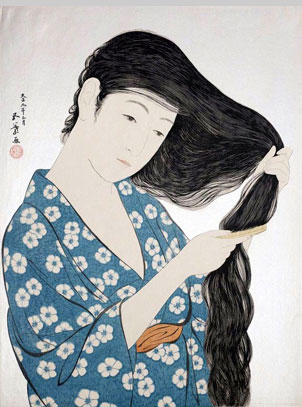
|
Shin-Hanga
  The shin-hanga or “new print” style that emerged in the early 20th century used the traditional guild production process to create richly refined woodblock prints of bird-and-flower subjects, female beauties, and neo-romantic scenes. The shin-hanga or “new print” style that emerged in the early 20th century used the traditional guild production process to create richly refined woodblock prints of bird-and-flower subjects, female beauties, and neo-romantic scenes.
“Woman in Blue Combing Her Hair,” 1920,
by Hashiguchi Goyō
S2003.8.121 |
  Many renderings by artists working in the “new print” mode conveyed a sense of timeless and unchanging tradition, even while occasionally romanticizing the intrusion of modernity. Many renderings by artists working in the “new print” mode conveyed a sense of timeless and unchanging tradition, even while occasionally romanticizing the intrusion of modernity.
|
  “Tennōji Temple in Snow, Osaka #139, 1927,
by Kawase Hasui “Tennōji Temple in Snow, Osaka #139, 1927,
by Kawase Hasui
S2003.8.686 |   “The Great Gate, Shiba, in Snow,“ 1936,
by Kawase Hasuiō “The Great Gate, Shiba, in Snow,“ 1936,
by Kawase Hasuiō
S2003.8.853
|
  Oda Kazuma’s rendering of a snow-covered bridge is a perfect example of the nostalgia for a bygone past that was typical of shin-hanga prints. Oda Kazuma’s rendering of a snow-covered bridge is a perfect example of the nostalgia for a bygone past that was typical of shin-hanga prints.
“Matsue Bridge In Snow,” 1924, by Oda Kazumay.
S2003.8.1626
|
  At the same time, however, Oda also produced urban scenes like this industrial cityscape that seems more typical of sōsaku-hanga preoccupations. At the same time, however, Oda also produced urban scenes like this industrial cityscape that seems more typical of sōsaku-hanga preoccupations.
“River Scene,”
ca. 1920
by Oda Kazuma
S2003.8.1627 | 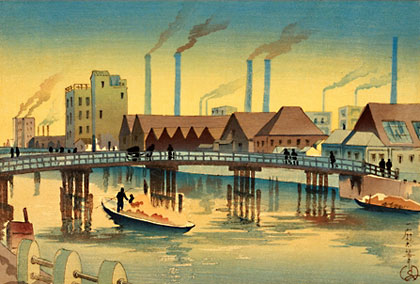
|
  This iron bridge was a favorite subject of both shin-hanga artists, as seen here, and sōsaku-hanga artists like Koizumi (see below). This iron bridge was a favorite subject of both shin-hanga artists, as seen here, and sōsaku-hanga artists like Koizumi (see below).
“Kiyosu Bridge,” 1936, by Kawase Hasui
S2003.8.761
Arthur M. Sackler Gallery, Smithsonian Institution, Robert O. Muller Collection
|
| |
In 1924, at the same time Hiratsuka’s earthquake series was circulating, Koizumi Kishio (1895–1945) published an instructional guide titled How to Carve and Print Woodblocks. This well-received and thoroughly practical work underscored a fundamental shift in the use of the woodblock print as a genre. For centuries print production was a guild activity in which the triumvirate of designer, block carver and printer worked under the direction of a publisher. Koizumi’s publication was a tool made available to any individual inclined to pursue the medium as a hobbyist or professional. His little book established the print as a form of personal expression.
Koizumi was a known figure in the world of personalized printmaking. From the age of sixteen he had been immersed in the avant-garde world of artists and publishers who were intent on broadening the horizons of the conservative Japanese art establishment through the infusion of European perspectives. In 1920, he issued a 12-print series celebrating views of Tokyo, especially in the old eastern part of the city around Asakusa, and other works followed. Much of this, however, still remained largely nostalgic. It took the Kantō earthquake and city that emerged from its ashes to propel Koizumi to the front rank of original chroniclers of Japan’s dramatic leap forward into modernity. His deservedly famous “100 Views of Tokyo in the Shōwa Era” (Shōwa Dai Tokyo Hyakuzue Hanga) was produced over an exceptionally long period of time, beginning in 1928 and continuing to late 1940.
“100 Views of New Tokyo” by Eight Artists
In 1928, at virtually the same time that Koizumi launched his homage to the new Tokyo, eight of his fellow artists working in the sōsaku-hanga mode announced a subscription series titled “100 Views of New Tokyo” (Shin Tokyo Hyakkei). The eight artists—Hiratsuka Un’ichi, Onchi Koshiro (1891–1955), Fukazawa Sakuichi (18966–1946), Kawakami Sumio (1895–1972), Maekawa Sempan (1888–1960), Fujimori Shizuo (1891–1943), Hemmi Takashi (1895–1944), and Suwa Kanenori (1897–1932)—agreed to produce the series over a period of four years, with each artist contributing 12 to 13 views.
Creating a memory of the swiftly changing city—or better, a snapshot of an existing moment—was the purported objective of the subscription series. There seems to be no record of a rivalry between the consortium and Koizumi. It is reasonable to suggest that all of these images were created not only in celebration of a rebirth, but also as a kind of memory hedge against possible future catastrophe and destruction. No one at the time, of course, could have predicted that a scant two decades after the earthquake Tokyo again would be turned to rubble, this time by the wartime firebombing carried out against over sixty Japanese cities by the United States.
Koizumi’s “100 Views”
Why Koizumi chose to launch a series on his own is not clear, but becomes clearer when considering evidence buried in his selection of scenes. Koizumi’s role as a nominator of new places, as a subtle provocateur introducing political innuendo in a traditional format, may be seen as his unique contribution to the genre. His submission to the 9th annual Imperial Exhibition (Teiten) in 1928 was the print that became the first view in his Tokyo series, the Eitai and Kiyosu bridges.
|
|
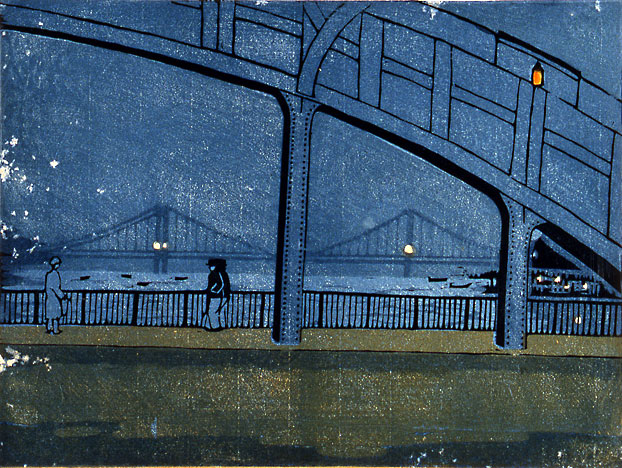
|
  “Eitai Bridge and Kiyosu Bridge (#01),” September 1928 “Eitai Bridge and Kiyosu Bridge (#01),” September 1928
Koizumi Kishio launched his “100 Views of Great Tokyo in the Shōwa Era” in the fall of 1928 with this image of two bridges spanning the Sumida River. The steel structures—rivets and electric lights prominent—symbolized the city's reconstruction and the Western-clothed figures embodied its modernity.
|
| |
The series started off slowly: the inaugural print in 1928, two prints in 1929, five in 1930, jumping to 11 in 1931, and then, with the exception of only six in 1933, moving at a pace numbering in the mid-teens until near completion in 1937. In 1940, six other images plus variant versions of places commemorated earlier were produced. Random prints of other sites actually raised the number in the series to one-hundred-and-nine views. Considering his other commissions and work as a woodblock cutter, Koizumi’s output was impressive.
The aesthetic appeal of Koizumi’s series lies in the understated personality that pervades the views. The idiosyncratic perspectives of a single individual are readily apparent, as is the soft, loving attention given to his highly distinctive cosmology. In some of his most effective compositions, Koizumi adopts a perspective that looks up to the main feature in the scene, whereas his panoramas or bird’s-eye views seem more detached. Powerful forms frequently burst beyond the frame of the print, suggesting an uncontrollable scale. Other scenes allow the composition to emerge like an opening fan, with greatness bestowed upon the subject by a benevolent blue sky. Still other prints variously employ the upper register of the composition to draw the eye from bottom to top. Views not so notable in ingenuity of composition or other technique can elicit an intellectual interest—or, sometimes, simply provoke the viewer’s curiosity and even perplexity about the artist’s choice of subject.
|
|
| |

|
|
|



